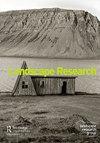Boundary thinking in landscape architecture and boundary-spanning roles of landscape architects
IF 1.7
3区 社会学
Q3 ENVIRONMENTAL STUDIES
引用次数: 2
Abstract
Abstract Landscape architects play important roles in addressing societal challenges. To successfully address these challenges, this essay argues that they need to expand their understanding of boundaries and engage in boundary thinking. Distinguishing between physical, mental and socially constructed boundaries, we characterise boundary thinking as a creative process and productive motive in designing landscapes. Subsequently, we present four types of boundary-spanning roles for landscape architects to perform—the subject-based designer, the visionary narrator, the process-based designer, and the design-led entrepreneur—and point to the cognitive and social capacities needed to play any of these roles. We propose for landscape architecture to consider boundary thinking in agenda setting discourses and to include boundary spanning into practice. We suggest three avenues to pursue in realising professional opportunities: exploring the roles landscape architects play, understanding the environment that enables boundary-spanning work, and developing boundary theory in landscape architectural research.景观建筑中的边界思维与景观建筑师的跨界角色
摘要景观建筑师在应对社会挑战方面发挥着重要作用。为了成功应对这些挑战,本文认为他们需要扩大对边界的理解,并进行边界思维。区分物理、心理和社会构建的边界,我们将边界思维描述为设计景观的创造性过程和生产动机。随后,我们为景观建筑师提供了四种类型的跨越边界的角色——基于主题的设计师、富有远见的叙述者、基于过程的设计师和以设计为主导的企业家——并指出了扮演任何这些角色所需的认知和社会能力。我们建议景观建筑学在议程设置话语中考虑边界思维,并将边界跨越纳入实践。我们提出了实现职业机会的三条途径:探索景观建筑师所扮演的角色,了解能够进行跨界工作的环境,以及发展景观建筑研究中的边界理论。
本文章由计算机程序翻译,如有差异,请以英文原文为准。
求助全文
约1分钟内获得全文
求助全文
来源期刊

Landscape Research
Multiple-
CiteScore
3.70
自引率
16.70%
发文量
63
期刊介绍:
Landscape Research, the journal of the Landscape Research Group, has become established as one of the foremost journals in its field. Landscape Research is distinctive in combining original research papers with reflective critiques of landscape practice. Contributions to the journal appeal to a wide academic and professional readership, and reach an interdisciplinary and international audience. Whilst unified by a focus on the landscape, the coverage of Landscape Research is wide ranging. Topic areas include: - environmental design - countryside management - ecology and environmental conservation - land surveying - human and physical geography - behavioural and cultural studies - archaeology and history
 求助内容:
求助内容: 应助结果提醒方式:
应助结果提醒方式:


